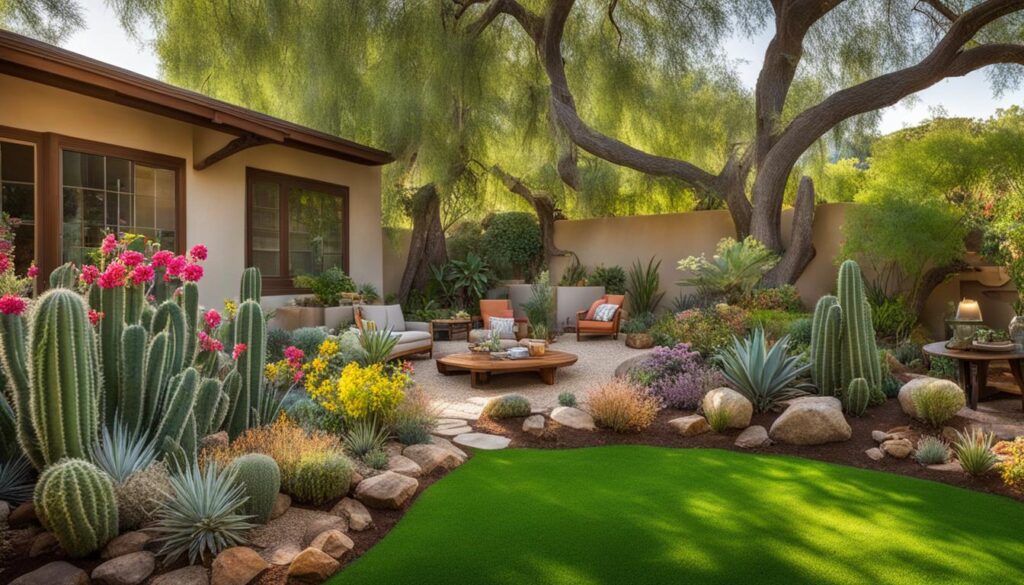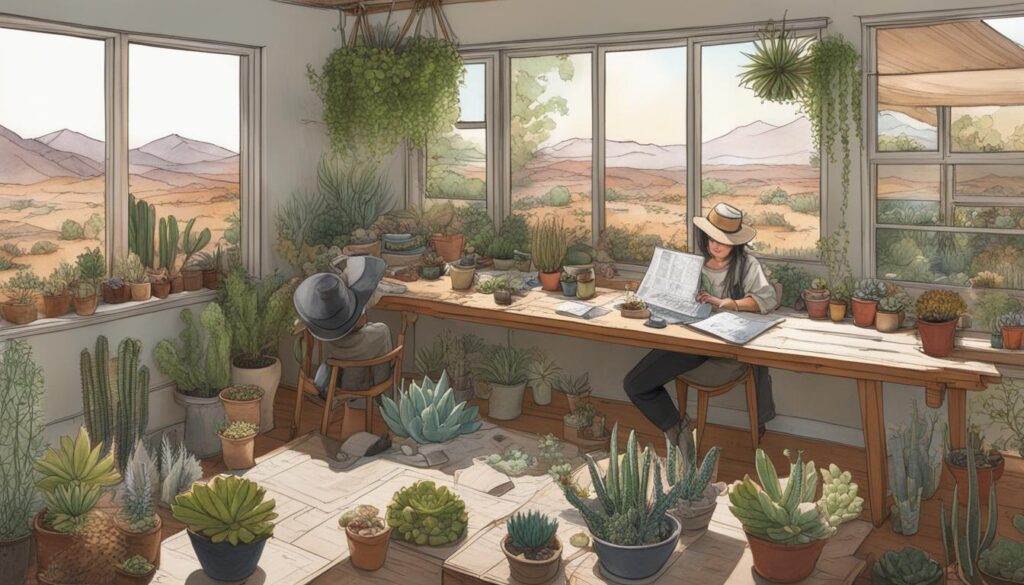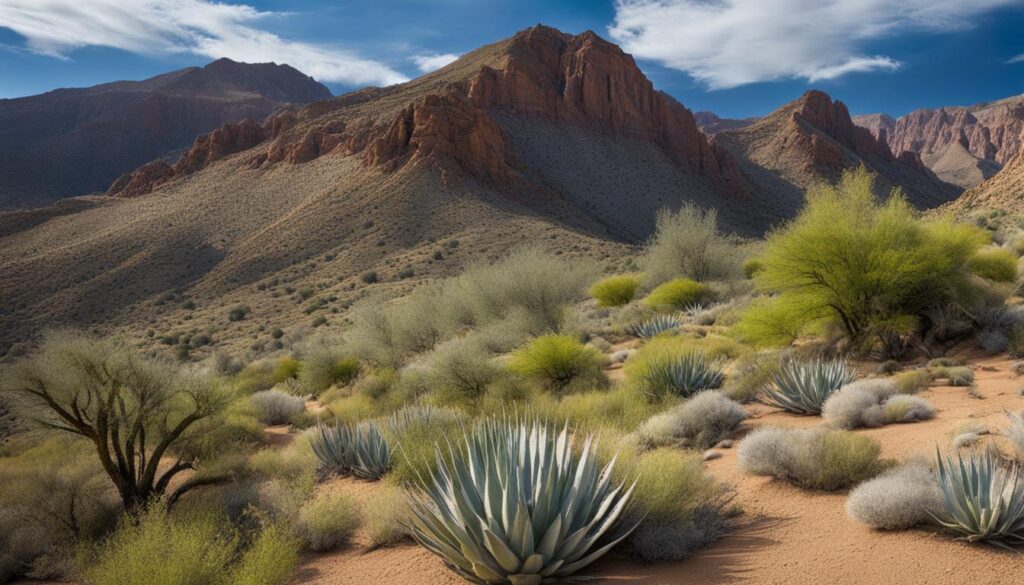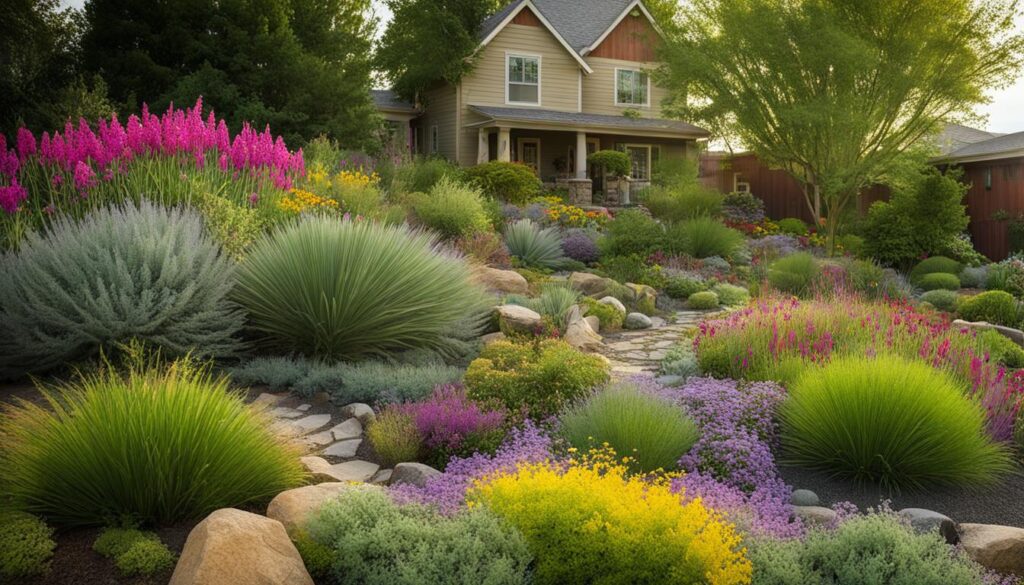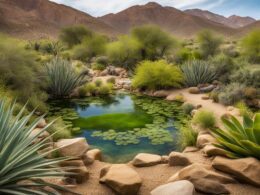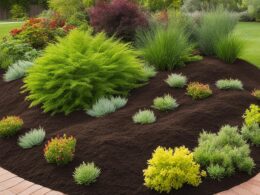Are you ready to transform your backyard into a sustainable oasis? By mastering the art of creating a native plant xeriscape plan, you can conserve water, save money, and create a beautiful and eco-friendly outdoor space. Xeriscaping is a landscaping approach that focuses on water conservation by utilizing plants that require minimal irrigation. Whether you have a dry climate or abundant rainfall, xeriscaping can be tailored to your specific environment and landscape, providing numerous benefits for both you and the environment.
When you create a native plant xeriscape plan, you’ll be selecting plants that are well-suited to your local environment, require minimal watering once established, and attract local pollinators and wildlife. By grouping plants with similar watering needs and considering the different layers of your landscape, such as trees, shrubs, and ornamental grasses, you can design a visually appealing and low-maintenance xeriscape. Furthermore, by implementing proper watering techniques, selecting low-maintenance varieties, and exploring alternative options for lawn areas, you can reduce maintenance and further enhance the water conservation and ecological benefits of your xeriscape plan.
Key Takeaways:
- Create a native plant xeriscape plan to conserve water and create a sustainable backyard environment.
- Select plants that are well-suited to your local environment and require minimal watering once established.
- Group plants with similar watering needs to efficiently irrigate your xeriscape.
- Consider the different layers of your landscape to design a visually appealing xeriscape.
- Implement proper watering techniques, select low-maintenance varieties, and explore alternative options for lawn areas to further enhance the water conservation and ecological benefits of your xeriscape plan.
Understanding Xeriscaping and Its Benefits
Xeriscaping is a landscaping approach that focuses on water conservation and utilizes plants that require minimal irrigation. While it originated in dry climates, it has expanded to all climate zones. Xeriscaping is not about completely eliminating landscaping but about selecting the right plants for the right places to minimize maintenance and water usage. Native plants and drought-tolerant non-natives are the best choices for xeriscapes as they are well-adapted to specific environments and require less watering once established. Xeriscaping offers several benefits such as decreased water consumption, cost savings, reduced maintenance, and the attraction of local pollinators and wildlife.
By understanding xeriscaping, you can make informed decisions when designing your landscape and create a sustainable outdoor space that not only conserves water but also enhances the natural beauty of your surroundings. Xeriscaping involves careful plant selection, grouping plants based on their water needs, and optimizing irrigation methods to minimize water wastage.
“Xeriscaping is not just about saving water; it is about creating beautiful, low-maintenance landscapes that are in harmony with the natural environment.”
With xeriscaping, you can transform your yard into an eco-friendly oasis, reduce your water bills, and contribute to the conservation of water resources. By embracing the benefits of xeriscaping, you can take a step towards a more sustainable and environmentally conscious lifestyle.
Table: Benefits of Xeriscaping
| Benefit | Description |
|---|---|
| Water Conservation | Xeriscaping reduces water consumption by utilizing plants that require minimal irrigation. |
| Cost Savings | By conserving water, xeriscaping can significantly reduce water bills and maintenance costs. |
| Reduced Maintenance | Xeriscaping minimizes the need for mowing, pruning, and watering, resulting in less time and effort spent on landscape upkeep. |
| Attracts Pollinators and Wildlife | Native plants in xeriscapes provide food and habitat for local pollinators and wildlife, promoting biodiversity and ecological balance. |
Designing Your Native Plant Xeriscape Plan
When it comes to designing your native plant xeriscape plan, it is crucial to consider the specific moisture requirements of the plants you choose. By grouping plants with similar watering needs, you can ensure efficient irrigation and minimize maintenance. Native plants and drought-tolerant non-natives should take center stage in your xeriscape plan, as they are well-suited to your local environment and require less water once established.
To create a visually appealing and sustainable design, think about incorporating different layers of plants in your landscape. Consider trees, shrubs, ornamental grasses, perennials, and annuals to add depth and variety. This multi-layered approach not only enhances the aesthetic appeal but also provides habitats for local pollinators and wildlife.
Improving moisture retention in the soil is another important aspect of designing your xeriscape plan. Incorporate organic compost or leaf mulch to nourish the soil and help it retain water. This will further reduce the need for frequent watering and contribute to water conservation efforts.
By carefully designing your xeriscape plan with consideration for moisture requirements, plant grouping, and soil enrichment, you can create a beautiful and low-maintenance landscape that conserves water and thrives in your specific environment.
Selecting the Right Plants for Your Xeriscape Plan
When choosing plants for your xeriscape plan, native species and drought-tolerant non-natives are the most suitable options. Native plants are well-adapted to your local climate, making them more resilient and requiring less water. Drought-tolerant non-natives can also thrive in your environment while offering additional colors and textures to your landscape.
Grouping plants with similar moisture requirements is essential for efficient irrigation and minimized maintenance. Consider creating zones based on water needs, such as grouping plants that require regular watering together and placing drought-tolerant varieties in separate areas. This strategy will allow you to tailor your watering routine and conserve water while providing optimal conditions for each plant.
Additionally, incorporating low-maintenance plant varieties can further minimize the time and effort required for upkeep. Look for plants that are naturally disease-resistant, require minimal pruning, and have a long flowering period. These varieties will not only reduce maintenance tasks but also contribute to the overall sustainability and beauty of your xeriscape plan.
Creating an Interactive Watering Schedule
Implementing an interactive watering schedule is crucial for the success of your xeriscape plan. Instead of following a fixed routine, monitor the soil moisture levels and adjust your watering accordingly. This approach ensures that each plant receives the appropriate amount of water without wastage.
An effective way to assess soil moisture is the finger test. Insert your finger into the soil around the plant’s root zone. If the soil feels damp, the plant does not need watering. If it feels dry, it’s time to water. This method allows you to water only when necessary, conserving water resources and preventing overwatering.
Incorporating a smart irrigation system with moisture sensors can also help automate the watering process and ensure efficient water usage. These systems detect soil moisture levels and only water when needed, saving both water and time in your xeriscape plan maintenance.
Implementing Your Xeriscape Plan and Maintenance Tips
Now that you have designed your native plant xeriscape plan, it’s time to put it into action and ensure its long-term success. Implementing your xeriscape plan involves proper preparation of the site, appropriate planting techniques, and regular maintenance. By following these steps and incorporating maintenance tips, you can create a beautiful, water-efficient, and low-maintenance landscape.
Proper Site Preparation
Before installing your xeriscape, it is crucial to prepare the site properly. Start by removing any existing vegetation, such as grass or weeds, from the area where you plan to create your xeriscape. This ensures a clean slate and minimizes competition for resources among plants. Additionally, make sure to improve the soil by adding organic matter, such as compost or peat moss, to increase its water-holding capacity and nutrient content.
Efficient Planting Techniques
When planting your native plants and drought-tolerant non-natives, keep in mind their water requirements and group them accordingly. This allows for more efficient irrigation by targeting specific areas with similar watering needs. Consider installing a drip irrigation system, which delivers water directly to the plant’s roots, minimizing water waste through evaporation or runoff.
Regular Maintenance
Maintaining your xeriscape is essential to keep it thriving and looking its best. This includes regular watering, pruning, and selecting low-maintenance plant varieties. Water newly planted native plants and drought-tolerant non-natives until they are established, typically for the first year. Once established, these plants require minimal watering as they are adapted to the local conditions.
Pruning is necessary to maintain the shape and health of your plants. Trim back perennials and remove any dead or damaged branches from trees and shrubs. Deadheading flowers also encourages new blooms and prolongs their flowering period. Selecting low-maintenance plant varieties, such as succulents or ornamental grasses, reduces the need for frequent pruning and upkeep.
By implementing your xeriscape plan and following these maintenance tips, you can enjoy a beautiful and sustainable landscape that requires less water and maintenance compared to traditional landscaping methods.
Adapting Xeriscaping to Your Specific Climate and Landscape
Xeriscaping can be customized to suit various climates and landscapes, allowing you to create a sustainable and visually appealing outdoor space that thrives in your specific environment. Whether you have a shade-drenched yard or an arid plot of land, there are xeriscaping techniques and plant choices that can be adapted to meet your unique needs.
Shade-Loving Plants for Cooler Climates
If you live in an area with lush soil and ample moisture, incorporating shade-loving plants into your xeriscape design can add depth and beauty to your landscape. Woodland gardening with perennials is an ideal choice for shady areas where the soil stays damp. Consider planting rhododendron, ferns, hostas, and creeping vinca, which thrive in these cool and shady conditions. These plants will bring vibrant colors and textures to your xeriscape while conserving water and minimizing maintenance.
Drought-Tolerant Groundcover for Dry Climates
In regions with dry and parched soil, drought-tolerant groundcover plants are a fantastic addition to your xeriscape plan. Opt for hardy creeping stonecrop and hens and chicks, which are succulents that require minimal water and are self-sufficient once established. These groundcovers not only add visual interest with their unique textures and colors but also help retain moisture in the soil, reducing the need for frequent watering.
Planting on a Grand Scale
If you have ample space and want to create a grand xeriscape, consider planting drought-tolerant trees and shrubs that provide a canopy and mid-level layers. Combine them with ornamental grasses and low-moisture perennials at the lower level to create a visually striking landscape that requires minimal watering. This approach is not only sustainable but also adds depth and variety to your outdoor space.
Table: Climate-Specific Adaptations in Xeriscaping
| Climate | Adaptation | Plant Choices |
|---|---|---|
| Cooler Climates | Shade-loving plants | Rhododendron, ferns, hostas, creeping vinca |
| Dry Climates | Drought-tolerant groundcover | Creeping stonecrop, hens and chicks |
| Ample Space | Planting on a grand scale | Drought-tolerant trees, shrubs, ornamental grasses, low-moisture perennials |
By adapting xeriscaping to your specific climate and landscape, you can create a sustainable and visually appealing outdoor space that requires less water and maintenance. Whether you’re dealing with shade, drought, or have ample space to work with, there are plant choices and techniques that can be tailored to meet your needs. Embrace the versatility of xeriscaping and create a beautiful, water-efficient landscape.
Reducing Lawn Area and Alternative Options
One effective strategy in xeriscaping is to reduce the area covered by traditional lawn grass. This not only minimizes the need for frequent mowing, fertilizing, and watering but also creates space for alternative options that are more sustainable and visually appealing. By reducing the lawn area, you can save time, money, and water while still maintaining a beautiful outdoor space.
One alternative option to consider is planting native ground cover plants. These plants are well-adapted to local climates and require less water and maintenance once established. Native ground covers, such as creeping thyme, moss phlox, or prairie dropseed, not only add color and texture to your landscape but also attract beneficial insects and wildlife. They help to retain moisture in the soil, prevent erosion, and reduce the need for additional irrigation.
Another option to reduce lawn area is to mow the grass at a higher height. By setting your lawnmower blades to a higher setting, you allow the grass to grow longer, which promotes deeper root growth and improves water retention. This simple adjustment can significantly reduce water evaporation from the soil and decrease the frequency of watering. Additionally, taller grass provides shade, keeping the soil cooler and reducing the growth of weeds. It also adds a natural, more relaxed look to your yard.
While reducing the lawn area may seem like a daunting task, the benefits are well worth the effort. Not only will you save time and resources, but you will also contribute to water conservation and create a more sustainable and environmentally friendly backyard. By exploring alternative options such as native ground cover plants and adjusting your mowing practices, you can transform your lawn into a vibrant and low-maintenance landscape that will thrive for years to come.
How Can I Incorporate Native Plants Into My DIY Xeriscaping Project?
When planning your diy xeriscaping projects article, consider incorporating native plants to conserve water and support local ecosystems. Research native species that are drought-tolerant and low-maintenance to thrive in your xeriscape, providing beauty and sustainability to your landscape.
Conclusion
In conclusion, creating a native plant xeriscape plan in your backyard offers numerous benefits. By selecting the right plants and grouping them based on their moisture requirements, you can minimize maintenance and conserve water. Native plants and drought-tolerant non-natives are the ideal choices as they are well-adapted to local environments and attract local pollinators and wildlife.
Implementing and maintaining your xeriscape plan requires proper watering, pruning, and selecting low-maintenance varieties. By following these practices, you can create a sustainable and beautiful landscape that requires less water and effort to maintain. Additionally, adapting xeriscaping to your specific climate and landscape allows for a personalized outdoor space that thrives in harmony with its surroundings.
Furthermore, reducing lawn areas and exploring alternative options not only enhances the water conservation and ecological benefits of your xeriscape plan but also contributes to creating a more sustainable backyard. By replacing traditional lawn grass with native ground cover plants or mowing the lawn at a higher height, you can save water, reduce maintenance, and improve water retention in the soil.
In summary, embracing the art of creating a native plant xeriscape plan enables you to enjoy the numerous benefits of water conservation, cost savings, reduced maintenance, and the creation of a sustainable and visually appealing backyard environment. By implementing the principles of xeriscaping and making conscious choices, you can create a beautiful oasis that supports local ecology and ensures a brighter future for both your backyard and the environment at large.






